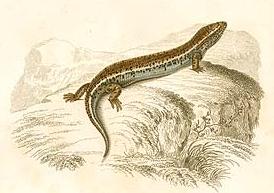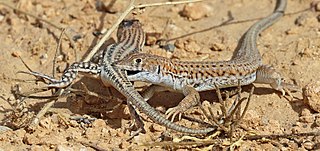Acontias is a genus of limbless skinks, the lance skinks, in the African subfamily Acontinae. Most are small animals, but the largest member of the genus is Acontias plumbeus at approximately 40 cm (16 in) snout-vent length. All members of this genus are live-bearing sandswimmers, with fused eyelids. A recent review moved species that were formerly placed in the genera Typhlosaurus, Acontophiops, and Microacontias into this genus, as together these form a single branch in the tree of life. This new concept of Acontias is a sister lineage to Typhlosaurus, and these two genera are the only genera within the subfamily Acontinae.

Chalcides is a genus of skinks.
Melanoseps is a genus of lizards, known commonly as limbless skinks, in the family Scincidae. The genus is endemic to Sub-Saharan Africa.
Scolecoseps is a genus of skinks, lizards in the family Scincidae. The genus is endemic to East Africa.

Tribolonotus is a genus of lizards, commonly known as crocodile skinks.

Typhlosaurus is a genus of African lizards, one of a number of genera of limbless lizards in the skink family (Scincidae). This group was recently revised with most species formerly attributed to Typhlosaurus now placed in Acontias. The current definition of Typhlosaurus includes five attenuate body legless lizards from southwestern Africa. This is the sister genus to Acontias, which together form the well supported Afrotropical subfamily Acontinae.

Dibamus is a genus of legless lizards in the family Dibamidae.

Acanthodactylus is a genus of lacertid lizards, commonly referred to as fringe-fingered lizards, fringe-toed lizards, and spiny-toed lizards.

Ophiomorus raithmai, known commonly as the eastern sand swimmer and the three-fingered sand-fish, is a species of skink, a lizard in the family Scincidae. The species is found in India and Pakistan.
Ophiomorus tridactylus, commonly known as the three-toed snake skink, is a species of skink endemic to sandy desert areas of South Asia. It is also called the Indian sand-swimmer for its habit of moving just under the sand.

Latast's snake skink is a species of skink, a lizard in the family Scincidae. The species is endemic to the Near East.

The Greek snake skink is a species of skink, a lizard in the family Scincidae.

Chioninia is a genus of skinks, lizards in the subfamily Lygosominae. For long, this genus was included in the "wastebin taxon" Mabuya. The genus Chioninia contains the Cape Verde mabuyas.

Maranjab's snake skink is a species of skink, a lizard in the family Scincidae. It can be found in north-east of Kashan, Dasht-e Kavir, Iran. From snout to vent 95 mm, tail 81 mm.
Ophiomorus blanfordii, also known commonly as Blanford's snake skink, is a species of lizard in the family Scincidae. The species is native to Western Asia and South Asia.
Chernov's snake skink is a species of skink, a lizard in the family Scincidae. The species is native to Western Asia and Central Asia.
Typhlacontias punctatissimus, also known commonly as the dotted blind dart skink, the speckled burrowing skink, and the speckled western burrowing skink, is a species of lizard in the family Scincidae. The species is native to southern Africa. Three subspecies are recognized.










